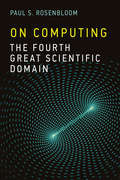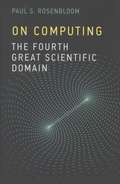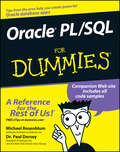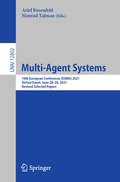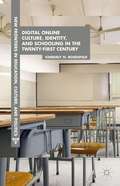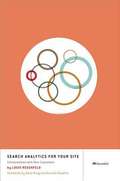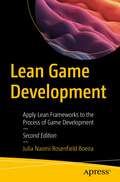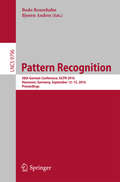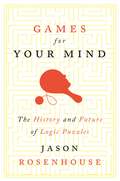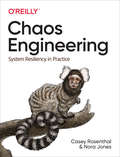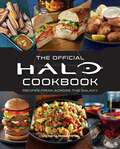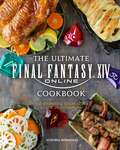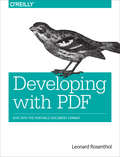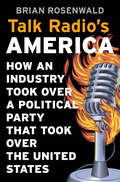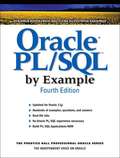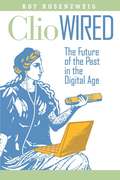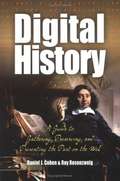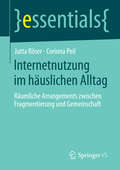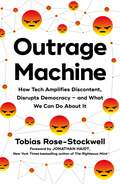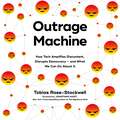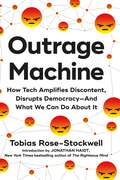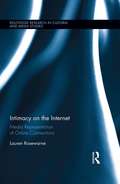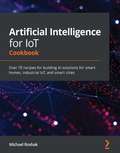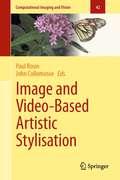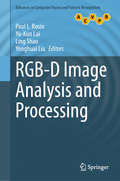- Table View
- List View
On Computing: The Fourth Great Scientific Domain
by Paul S. RosenbloomA proposal that computing is not merely a form of engineering but a scientific domain on a par with the physical, life, and social sciences.Computing is not simply about hardware or software, or calculation or applications. Computing, writes Paul Rosenbloom, is an exciting and diverse, yet remarkably coherent, scientific enterprise that is highly multidisciplinary yet maintains a unique core of its own. In On Computing, Rosenbloom proposes that computing is a great scientific domain on a par with the physical, life, and social sciences. Rosenbloom introduces a relational approach for understanding computing, conceptualizing it in terms of forms of interaction and implementation, to reveal the hidden structures and connections among its disciplines. He argues for the continuing vitality of computing, surveying the leading edge in computing's combination with other domains, from biocomputing and brain-computer interfaces to crowdsourcing and virtual humans to robots and the intermingling of the real and the virtual. He explores forms of higher order coherence, or macrostructures, over complex computing topics and organizations. Finally, he examines the very notion of a great scientific domain in philosophical terms, honing his argument that computing should be considered the fourth great scientific domain.With On Computing, Rosenbloom, a key architect of the founding of University of Southern California's Institute for Creative Technologies and former Deputy Director of USC's Information Sciences Institute, offers a broader perspective on what computing is and what it can become.
On Computing
by Paul S. RosenbloomComputing isn't simply about hardware or software, or calculation or applications. Computing, writes Paul Rosenbloom, is an exciting and diverse, yet remarkably coherent, scientific enterprise that is highly multidisciplinary yet maintains a unique core of its own. In On Computing, Rosenbloom proposes that computing is a great scientific domain on a par with the physical, life, and social sciences. Rosenbloom introduces a relational approach for understanding computing, conceptualizing it in terms of forms of interaction and implementation, to reveal the hidden structures and connections among its disciplines. He argues for the continuing vitality of computing, surveying the leading edge in computing's combination with other domains, from biocomputing and brain-computer interfaces to crowdsourcing and virtual humans to robots and the intermingling of the real and the virtual. He explores forms of higher order coherence, or macrostructures, over complex computing topics and organizations, such as computing's role in the pursuit of science and the structure of academic computing. Finally, he examines the very notion of a great scientific domain in philosophical terms, honing his argument that computing should be considered the fourth great scientific domain. Rosenbloom's proposal may prove to be controversial, but the intent is to initiate a long overdue conversation about the nature and future of a field in search of its soul. Rosenbloom, a key architect of the founding of University of Southern California's Institute for Creative Technologies and former Deputy Director of USC's Information Sciences Institute, offers a broader perspective on what computing is and what it can become.
Oracle PL/SQL For Dummies
by Michael Rosenblum Dr Paul DorseyFind tips for creating efficient PL/SQL code If you know a bit about SQL, this book will make PL/SQL programming painless! The Oracle has spoken-you need to get up to speed on PL/SQL programming, right? We predict it'll be a breeze with this book! You'll find out about code structures, best practices, and code naming standards, how to use conditions and loops, where to place PL/SQL code in system projects, ways to manipulate data, and more. Discover how to Write efficient, easy-to-maintain code Test and debug PL/SQL routines Integrate SQL and PL/SQL Apply PL/SQL best practices Use new features introduced in Oracle 9i and 10g
Multi-Agent Systems: 18th European Conference, EUMAS 2021, Virtual Event, June 28–29, 2021, Revised Selected Papers (Lecture Notes in Computer Science #12802)
by Ariel Rosenfeld Nimrod TalmonThis book constitutes the revised post-conference proceedings of the 18th European Conference on Multi-Agent Systems, EUMAS 2021. The conference was held online in June, 2021. 16 full papers are presented in this volume, each of which carefully reviewed and selected from a total of 51 submissions. The papers report on both early and mature research and cover a wide range of topics in the field of multi-agent systems.
Digital Online Culture, Identity, and Schooling in the Twenty-First Century
by Kimberly N. RosenfeldDigital Online Culture, Identity and Schooling in the Twenty-First Century provides a cultural, ideological critique of identity construction in the context of virtualization. Kimberly Rosenfeld explores the growing number of people who no longer reside in one physical reality but live, work, and play in multiple realities. Rosenfeld's critique of neo-liberal practices in the digital environment brings to light the on-going hegemonic and counter-hegemonic battles over control of education in the digital age. Rosenfeld draws conclusions for empowering the population through schooling, and how it should understand, respond to, and help individuals live out the information revolution.
Search Analytics for Your Site
by Louis RosenfeldAny organization that has a searchable web site or intranet is sitting on top of hugely valuable and usually under-exploited data: logs that capture what users are searching for, how often each query was searched, and how many results each query retrieved. Search queries are gold: they are real data that show us exactly what users are searching for in their own words. This book shows you how to use search analytics to carry on a conversation with your customers: listen to and understand their needs, and improve your content, navigation and search performance to meet those needs.
Lean Game Development: Apply Lean Frameworks to the Process of Game Development
by Julia Naomi Rosenfield BoeiraMaster Lean UX and Lean Startup techniques to improve your agile game development experience beyond Scrum. This updated version of the book focuses on applying lean and agile methodologies to the game development process and features improved examples, applied techniques, and a whole new section explaining how to test a game in Unity with CI. You'll see how to define a minimum viable product (MVP) for games with Lean Canvas, allowing customers to iterate over it and collect feedback for improvement at every cycle. All of these are achieved while still using standard Agile techniques. The first part of the book explains the ideation process of a game and how lean methodologies allow developers, especially small studios, to avoid scope creep. Next, it it provides guidance on creating MVPs and using player feedback to iterate and improve games. The book then discusses continual improvement (CI) methods. A crucial part of CI is generation of Lean Canvas. Lean Game Development, Second Edition shows you how to iterate until you develop a game that satisfies developers, gamers, and your studio's financial goals.What You'll LearnStudy lean and agile methodologies to enhance the game development process Find out how to improve the way game productions define value and iterate over itApply development strategies to enrich the game development processWho This Book Is ForPeople from all sectors of the gaming industry will find the book useful in planning their project in a more iterative way, unloading the management burden on the development process and collecting feedback to improve the game content as early as possible.
Pattern Recognition
by Bodo Rosenhahn Bjoern AndresThis book constitutes the refereed proceedings of the 38th German Conference on Pattern Recognition, GCPR 2016, held in Hannover, Germany, in September 2016. The 36 revised full papers presented were carefully reviewed and selected from 85 submissions. The papers are organized in topical sections on image processing, learning, optimization, segmentation, applications, image analysis, motion and tracking.
Games for Your Mind: The History and Future of Logic Puzzles
by Jason RosenhouseA lively and engaging look at logic puzzles and their role in recreation, mathematics, and philosophyLogic puzzles were first introduced to the public by Lewis Carroll in the late nineteenth century and have been popular ever since. Games like Sudoku and Mastermind are fun and engrossing recreational activities, but they also share deep foundations in mathematical logic and are worthy of serious intellectual inquiry. Games for Your Mind explores the history and future of logic puzzles while enabling you to test your skill against a variety of puzzles yourself.In this informative and entertaining book, Jason Rosenhouse begins by introducing readers to logic and logic puzzles and goes on to reveal the rich history of these puzzles. He shows how Carroll's puzzles presented Aristotelian logic as a game for children, yet also informed his scholarly work on logic. He reveals how another pioneer of logic puzzles, Raymond Smullyan, drew on classic puzzles about liars and truthtellers to illustrate Kurt Gödel's theorems and illuminate profound questions in mathematical logic. Rosenhouse then presents a new vision for the future of logic puzzles based on nonclassical logic, which is used today in computer science and automated reasoning to manipulate large and sometimes contradictory sets of data.Featuring a wealth of sample puzzles ranging from simple to extremely challenging, this lively and engaging book brings together many of the most ingenious puzzles ever devised, including the "Hardest Logic Puzzle Ever," metapuzzles, paradoxes, and the logic puzzles in detective stories.
Chaos Engineering: System Resiliency in Practice
by Casey Rosenthal Nora JonesAs more companies move toward microservices and other distributed technologies, the complexity of these systems increases. You can’t remove the complexity, but through Chaos Engineering you can discover vulnerabilities and prevent outages before they impact your customers. This practical guide shows engineers how to navigate complex systems while optimizing to meet business goals.Two of the field’s prominent figures, Casey Rosenthal and Nora Jones, pioneered the discipline while working together at Netflix. In this book, they expound on the what, how, and why of Chaos Engineering while facilitating a conversation from practitioners across industries. Many chapters are written by contributing authors to widen the perspective across verticals within (and beyond) the software industry.Learn how Chaos Engineering enables your organization to navigate complexityExplore a methodology to avoid failures within your application, network, and infrastructureMove from theory to practice through real-world stories from industry experts at Google, Microsoft, Slack, and LinkedIn, among othersEstablish a framework for thinking about complexity within software systemsDesign a Chaos Engineering program around game days and move toward highly targeted, automated experimentsLearn how to design continuous collaborative chaos experiments
Halo: The Official Cookbook (Gaming)
by Victoria RosenthalTravel through the otherworldly culinary adventures of the Halo universe!They say an army marches on its stomach, and the UNSC is no exception! Learn to make awesome appetizers, sumptuous snacks, decadent desserts, and main dishes to fuel even the hungriest of Spartans on the longest of missions. With step-by-step instructions and beautiful photography, this book gives you everything you need to go from Master Chief to Master Chef. OVER 70 RECIPES FOR EVERY OCCASION: From portable snacks you can take with you in the Warthog to decadent spreads to feed the entire squadron, this book contains recipes to satisfy every UNSC member and beyond! PERFECT FOR COOKS OF EVERY SKILL LEVEL: With step-by step directions and beautiful photos, learn to make foods inspired by the iconic Halo universe—whether you&’re an experienced cook or a raw recruit, this book gives you the intel you need to complete your culinary mission. INSPIRING PHOTOGRAPHY: Gorgeous photos of finished recipes help ensure success. A STUNNING ADDITION TO YOUR COLLECTION: This exquisitely detailed hardcover book is the perfect acquisition for your kitchen library—a must have for every Halo fan.
The Ultimate Final Fantasy XIV Cookbook: The Essential Culinarian Guide to Hydaelyn (Gaming)
by Victoria RosenthalTravel through the exciting culinary world of FINAL FANTASY XIV.Journey through the rich culinary landscape of FINAL FANTASY XIV. Featuring favorite flavors from across Hydaelyn and Norvrandt and easy-to-follow instructions, this tome provides numerous tips on how to make the most of your ingredients. Start your day with Farmer&’s Breakfast, a very famous and simple-yet-delightful dish; savor the Knight&’s Bread of Coerthas; dive into La Noscea&’s Rolanberry Cheesecake, and many more. · Exclusive Foreword written by game director, Naoki Yoshida. · Perfect for cooks of every skill level. With step-by-step directions and beautiful photos, learn to make iconic in-game foods, bringing the lush culinary landscape of FINAL FANTASY XIV to life. · Over 70 Recipes for every occasion. From quick snacks you can enjoy while exploring Eorzea to decadent desserts and meals fit for royalty, this book contains recipes for both simple and celebratory fare. · Inspiring Photography. Gorgeous photos of finished recipes help ensure success! · A stunning addition to your collection. This exquisitely detailed hardcover book is the perfect acquisition for your kitchen library—a must have for every FINAL FANTASY fan.
Developing with PDF: Dive Into the Portable Document Format (Oreilly and Associate)
by Leonard RosentholPDF is becoming the standard for digital documents worldwide, but it's not easy to learn on your own. With capabilities that let you use a variety of images and text, embed audio and video, and provide links and navigation, there's a lot to explore. This practical guide helps you understand how to work with PDF to construct your own documents, troubleshoot problems, and even build your own tools. You'll also find best practices for producing, manipulating, and consuming PDF documents. In addition, this highly approachable reference will help you navigate the official (and complex) ISO documentation. Learn how to combine PDF objects into a cohesive whole Use PDF's imaging model to create vector and raster graphics Integrate text, and become familiar with fonts and glyphs Provide navigation within and between documents Use annotations to overlay or incorporate additional content Build interactive forms with the Widget annotation Embed related files such as multimedia, 3D content, and XML files Use optional content to enable non-printing graphics Tag content with HTML-like structures, including paragraphs and tables
Talk Radio’s America: How an Industry Took Over a Political Party That Took Over the United States
by Brian RosenwaldThe march to the Trump presidency began in 1988, when Rush Limbaugh went national. Brian Rosenwald charts the transformation of AM radio entertainers into political kingmakers. By giving voice to the conservative base, they reshaped the Republican Party and fostered demand for a president who sounded as combative and hyperbolic as a talk show host.
Oracle PL/SQL by Example (4th edition)
by Benjamin Rosenzweig Elena Silvestrova RakhimovUsing hands-on labs, extensive examples, exercises, and projects, this tutorial teaches basic PL/SQL concepts and general programming fundamentals, covering conditional and iterative program control techniques, error and exception handling, working with cursors and triggers (including Oracle 11g's new compound triggers), and working with advanced PL/SQL capabilities such as object-relational features and bulk SQL. Appendices offer a PL/SQL formatting guide, sample database schema, and an ANSI SQL standards reference. Rosenzweig is a software development manager. Rakhimov is a software developer. Annotation ©2008 Book News, Inc. , Portland, OR (booknews. com)
Clio Wired: The Future of the Past in the Digital Age
by Roy RosenzweigIn these visionary essays, Roy Rosenzweig charts the impact of new media on teaching, researching, preserving, presenting, and understanding history. Negotiating between the "cyberenthusiasts" who champion technological breakthroughs and the "digitalskeptics" who fear the end of traditional humanistic scholarship, Rosenzweig re-envisions academic historians' practices and professional rites while analyzing and advocating for amateur historians' achievements. While he addresses the perils of "doing history" online, Rosenzweig eloquently identifies the promises of digital work, detailing innovative strategies for powerful searches in primary and secondary sources, the increased opportunities for dialogue and debate, and, most of all, the unprecedented access afforded by the Internet. Rosenzweig draws attention to the opening up of the historical record to new voices, the availability of documents and narratives to new audiences, and the attractions of digital technologies for new and diverse practitioners. Though he celebrates digital history's democratizing influences, Rosenzweig also argues that we can only ensure the future of the past in this digital age by actively resisting the efforts of corporations to put up gates and profit from the Web.
Digital History: A Guide to Gathering, Preserving, and Presenting the Past on the Web
by Roy Rosenzweig Daniel J. CohenCohen and Rosenzweig take their experiences with a project at George Mason U. titled "Echo: Exploring and Collecting History Online; Science, Technology, and Industry" and build them into an introduction to the Web for historians who want to produce or improve an online exhibit. They walk readers (teachers, students, activists, curators, amateur enthusiasts) through the process of planning a project, understanding the technologies involved, and responding to an intended audience effectively. Discussion includes coverage of copyright law and fair use for scholars, and of evolving Web techniques that enable interactivity. Annotation ©2005 Book News, Inc., Portland, OR (booknews.com)
Internetnutzung im häuslichen Alltag: Räumliche Arrangements zwischen Fragmentierung und Gemeinschaft (essentials)
by Jutta Röser Corinna PeilDer Beitrag präsentiert aktuelle Befunde zur Internetnutzung im häuslichen Alltag. Die Autorinnen nehmen zunächst eine Systematisierung alltagsbezogener Rezeptionsforschung der Cultural Studies vor und führen den Domestizierungsansatz ein. Auf Basis ethnografisch orientierter Haushaltsstudien wird anschließend aufgezeigt, auf welche Weise Internetnutzung, räumliche Arrangements und häusliche Kommunikationsstrukturen miteinander interagieren. Abschließend werden verschiedene Arrangements beschrieben und deren Einflüsse auf die Herstellung von Gemeinschaft und Fragmentierung, auf geschlechtsgebundene Praktiken sowie auf Funktionen anderer Medien, insbesondere des Fernsehens, skizziert.
Outrage Machine: How Tech Amplifies Discontent, Disrupts Democracy – and What We Can Do About It
by Tobias Rose-StockwellForeword by Jonathan Haidt, author of THE RIGHTEOUS MINDAn invaluable guide to understanding the technology that captures our attention with anger.The original internet was not designed to make us upset, distracted, confused, and outraged. But something unexpected happened at the turn of the last decade, when a handful of small features were quietly launched at social media companies with little fanfare. Together, they triggered a cascading set of dramatic changes to how media, politics, and society itself operates-inadvertently creating an Outrage Machine we cannot ignore.Author, designer, and media researcher Tobias Rose-Stockwell shares the defining shifts caused by these technologies, and how they have ignited a society-wide crisis of trust. Drawing from cutting-edge research and vivid personal anecdotes, Rose-Stockwell illustrates how social media has bound us to an unprecedented system of public performance, training us to react rather than reflect, and attack rather than debate.OUTRAGE MACHINE reveals the triggers and tactics used to exploit our anger, unpacking how these tools hack our deep tribal instincts and psychological vulnerabilities, and how they have become opportunistic platforms for authoritarians and a threat to democratic norms everywhere.But this book is not just about the problem. In a story spanning continents and generations, Rose-Stockwell explores how every new media technology disrupts our ability to make sense of the world, from the printing press to the telegraph, from radio to television. OUTRAGE MACHINE situates social media within a historical cycle of confusion, violence, and emerging tolerance. Using clear language and powerful illustrations, this book reveals the magnitude of the challenges we face, while offering realistic solutions and a promising pathway out.
Outrage Machine: How Tech Amplifies Discontent, Disrupts Democracy – and What We Can Do About It
by Tobias Rose-StockwellForeword by Jonathan Haidt, author of THE RIGHTEOUS MINDAn invaluable guide to understanding the technology that captures our attention with anger.The original internet was not designed to make us upset, distracted, confused, and outraged. But something unexpected happened at the turn of the last decade, when a handful of small features were quietly launched at social media companies with little fanfare. Together, they triggered a cascading set of dramatic changes to how media, politics, and society itself operates-inadvertently creating an Outrage Machine we cannot ignore.Author, designer, and media researcher Tobias Rose-Stockwell shares the defining shifts caused by these technologies, and how they have ignited a society-wide crisis of trust. Drawing from cutting-edge research and vivid personal anecdotes, Rose-Stockwell illustrates how social media has bound us to an unprecedented system of public performance, training us to react rather than reflect, and attack rather than debate.OUTRAGE MACHINE reveals the triggers and tactics used to exploit our anger, unpacking how these tools hack our deep tribal instincts and psychological vulnerabilities, and how they have become opportunistic platforms for authoritarians and a threat to democratic norms everywhere.But this book is not just about the problem. In a story spanning continents and generations, Rose-Stockwell explores how every new media technology disrupts our ability to make sense of the world, from the printing press to the telegraph, from radio to television. OUTRAGE MACHINE situates social media within a historical cycle of confusion, violence, and emerging tolerance. Using clear language and powerful illustrations, this book reveals the magnitude of the challenges we face, while offering realistic solutions and a promising pathway out.
Outrage Machine: How Tech Amplifies Discontent, Disrupts Democracy—And What We Can Do About It
by Tobias Rose-StockwellAmazon's Best History Book of the Month for July 2023An invaluable guide to understanding how the internet has broken our brains—and what we can do to fix it. The original internet was not designed to make us upset, distracted, confused, and outraged. But something unexpected happened at the turn of the last decade, when a handful of small features were quietly launched at social media companies with little fanfare. Together, they triggered a cascading set of dramatic changes to how media, politics, and society itself operate—inadvertently creating an Outrage Machine we cannot ignore. Author, designer, and media researcher Tobias Rose-Stockwell shares the defining shifts caused by these technologies, and how they have ignited a society-wide crisis of trust. Drawing from cutting-edge research and vivid personal anecdotes, Rose-Stockwell illustrates how social media has bound us to an unprecedented system of public performance, training us to react rather than reflect, and attack rather than debate.Outrage Machine reveals the triggers and tactics used to exploit our anger, unpacking how these tools hack our deep tribal instincts and psychological vulnerabilities, and how they have become opportunistic platforms for authoritarians and a threat to democratic norms everywhere. But this book is not just about the problem. In a story spanning continents and generations, Rose-Stockwell explores how every new media technology disrupts our ability to make sense of the world, from the printing press to the telegraph, from radio to television. Outrage Machine situates social media within a historical cycle of confusion, violence, and emerging tolerance. Using clear language and powerful illustrations, this book reveals the magnitude of the challenges we face, while offering realistic solutions and a promising pathway out.
Intimacy on the Internet: Media Representations of Online Connections (Routledge Research in Cultural and Media Studies)
by Lauren RosewarneThe focus of this book is on the media representations of the use of the Internet in seeking intimate connections—be it a committed relationship, a hook-up, or a community in which to dabble in fringe sexual practices. Popular culture (film, narrative television, the news media, and advertising) present two very distinct pictures of the use of the Internet as related to intimacy. From news reports about victims of online dating, to the presentation of the desperate and dateless, the perverts and the deviants, a distinct frame for the intimacy/Internet connection is negativity. In some examples however, a changing picture is emerging. The ubiquitousness of Internet use today has meant a slow increase in comparatively more positive representations of successful online romances in the news, resulting in more positive-spin advertising and a more even-handed presence of such liaisons in narrative television and film. Both the positive and the negative media representations are categorised and analysed in this book to explore what they reveal about the intersection of gender, sexuality, technology and the changing mores regarding intimacy.
Artificial Intelligence for IoT Cookbook: Over 70 recipes for building AI solutions for smart homes, industrial IoT, and smart cities
by Michael RoshakImplement machine learning and deep learning techniques to perform predictive analytics on real-time IoT dataKey FeaturesDiscover quick solutions to common problems that you'll face while building smart IoT applicationsImplement advanced techniques such as computer vision, NLP, and embedded machine learningBuild, maintain, and deploy machine learning systems to extract key insights from IoT dataBook DescriptionArtificial intelligence (AI) is rapidly finding practical applications across a wide variety of industry verticals, and the Internet of Things (IoT) is one of them. Developers are looking for ways to make IoT devices smarter and to make users' lives easier. With this AI cookbook, you'll be able to implement smart analytics using IoT data to gain insights, predict outcomes, and make informed decisions, along with covering advanced AI techniques that facilitate analytics and learning in various IoT applications. Using a recipe-based approach, the book will take you through essential processes such as data collection, data analysis, modeling, statistics and monitoring, and deployment. You'll use real-life datasets from smart homes, industrial IoT, and smart devices to train and evaluate simple to complex models and make predictions using trained models. Later chapters will take you through the key challenges faced while implementing machine learning, deep learning, and other AI techniques, such as natural language processing (NLP), computer vision, and embedded machine learning for building smart IoT systems. In addition to this, you'll learn how to deploy models and improve their performance with ease. By the end of this book, you'll be able to package and deploy end-to-end AI apps and apply best practice solutions to common IoT problems.What you will learnExplore various AI techniques to build smart IoT solutions from scratchUse machine learning and deep learning techniques to build smart voice recognition and facial detection systemsGain insights into IoT data using algorithms and implement them in projectsPerform anomaly detection for time series data and other types of IoT dataImplement embedded systems learning techniques for machine learning on small devicesApply pre-trained machine learning models to an edge deviceDeploy machine learning models to web apps and mobile using TensorFlow.js and JavaWho this book is forIf you're an IoT practitioner looking to incorporate AI techniques to build smart IoT solutions without having to trawl through a lot of AI theory, this AI IoT book is for you. Data scientists and AI developers who want to build IoT-focused AI solutions will also find this book useful. Knowledge of the Python programming language and basic IoT concepts is required to grasp the concepts covered in this artificial intelligence book more effectively.
Image and Video-Based Artistic Stylisation
by Paul Rosin John CollomosseNon-photorealistic rendering (NPR) is a combination of computer graphics and computer vision that produces renderings in various artistic, expressive or stylized ways such as painting and drawing. This book focuses on image and video based NPR, where the input is a 2D photograph or a video rather than a 3D model. 2D NPR techniques have application in areas as diverse as consumer and professional digital photography and visual effects for TV and film production. The book covers the full range of the state of the art of NPR with every chapter authored by internationally renowned experts in the field, covering both classical and contemporary techniques. It will enable both graduate students in computer graphics, computer vision or image processing and professional developers alike to quickly become familiar with contemporary techniques, enabling them to apply 2D NPR algorithms in their own projects.
RGB-D Image Analysis and Processing (Advances in Computer Vision and Pattern Recognition)
by Paul L. Rosin Yu-Kun Lai Ling Shao Yonghuai LiuThis book focuses on the fundamentals and recent advances in RGB-D imaging as well as covering a range of RGB-D applications. The topics covered include: data acquisition, data quality assessment, filling holes, 3D reconstruction, SLAM, multiple depth camera systems, segmentation, object detection, salience detection, pose estimation, geometric modelling, fall detection, autonomous driving, motor rehabilitation therapy, people counting and cognitive service robots. The availability of cheap RGB-D sensors has led to an explosion over the last five years in the capture and application of colour plus depth data. The addition of depth data to regular RGB images vastly increases the range of applications, and has resulted in a demand for robust and real-time processing of RGB-D data. There remain many technical challenges, and RGB-D image processing is an ongoing research area. This book covers the full state of the art, and consists of a series of chapters by internationally renowned experts in the field. Each chapter is written so as to provide a detailed overview of that topic. RGB-D Image Analysis and Processing will enable both students and professional developers alike to quickly get up to speed with contemporary techniques, and apply RGB-D imaging in their own projects.
